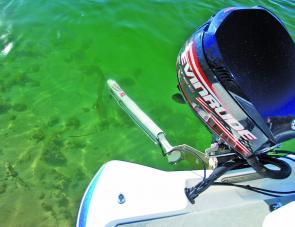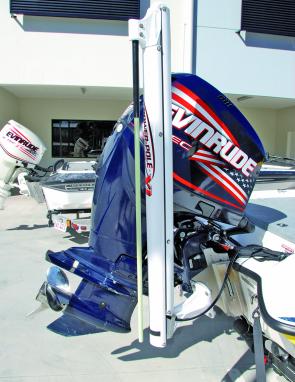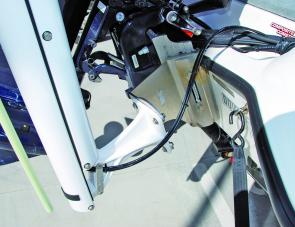Around fifteen years ago, I got lean-seats and a bow-mounted electric motor fitted to my homemade bass boat before shooting off with fishing mate Craig Johnson to the Northern Territory. The comments were the same at every service station we stopped at to re-fuel.
“What the hell are those things sticking up out of your boat and what’s that thing on the front?” the general line of questioning. Like a smart aleck I’d usually reply, “A radar and a harpoon launcher.” I probably should have been beaten up more than I did. Aussies are pretty tolerant of wise guys.
Nowadays, bass style boats are pretty well known by a percentage of the general public. Only one in three ask where I’m going skiing. But nearly everyone now asks, “What the hell is that thing sticking up next to the outboard.”
“It’s a Power Pole,” I tell them. Well, if it’s a kid, I might still call it a ‘stingray stabber’ before showing them how it works.
A Power Pole is a shallow water anchor. Not your traditional kind, with a rope, chain and something like Popeye’s tattoo attached to the end. It’s a mechanism for pushing a solid fibreglass rod onto the bottom and bringing your boat to a standstill in water around seven feet or less deep.
How does it work? Simply, when activated, a hydraulic ram activates the pole and it uses a scissor action to deploy the device. Retrieving the pole simply reverses the process – the hydraulic ram retracts and the pole is lifted from the bottom.
There are two ways the pole can be activated. One is a hard-wired switch. On the Fishing Monthly Stratos, this was installed in the bow console, so you can activate it with your toe while you’re fishing from the front. There’s also an optional wireless remote unit that you can keep on you to operate the pole from anywhere in (and out of) the boat.
In practice, I use the hard-wired switch 99% of the time. The wireless gets used for demonstrating how the pole works at the servo or at a boat show. Others that have the poles use the wireless remote more than I do.
Josh from Skeeter – the importer and retailer of the Power Poles – said that I’d be able to install the Power Pole myself. I was a little dubious. I’m better at dealing with tools rather than using them. But Josh was right, carefully reading the instructions and a few basic instruments has the Power Pole in and working in about an hour.
I also stipulated that I wasn’t prepared to drill gaping holes in the fibreglass hull, so Josh supplied a custom built bracket that attached to the outboard’s jacking plate. It meant that the only drilling involved was a few screw-holes in the inside of the rear well to mount the hydraulic pump and wireless remote receiver. Which was totally acceptable.
Initially, my impression was that there was too much play in the bracket and pole and that the bracket would work-harden and crack. After six months, this hasn’t happened and I believe that the movement in the system is a necessary buffer to spread the load of holding the boat – especially in current – across several components.
In fact, the solid, fibreglass rod that ultimately punches into the sea floor in incredibly robust. I think you’d need a brave driver and a Snatch-em Strap to bust it.
After using the Power Pole for a season, there are lots of things I like about it.
Firstly, it offers a super quick way of stopping your boat from drifting over prime fishing areas. For example when fishing flats for bream you can sometimes fish for 500m without a bite and then hook-up to a cracker. He has a dozen mates with him. Pre-power-pole I’d drift through the zone while landing the bream and spook all of his mates. Now I can deploy the pole with the toe while fighting the fish and have a chance at a second fish from that school immediately, rather than having to wait 15 minutes for the fish to feed again.
During the BARRA tour, Gary Boyd found the Pole equally useful. He used it to silently stop the boat in front of lay downs without backwashing the timber with electric motor thrust.
Environmentally, it’s a winner, instead of deploying conventional anchors in weed beds, the Power Pole’s footprint is only about one square inch. And there’s no messy mud and weeds to clean off the anchor before bringing it onboard.
Ever wondered if a rattling anchor chain scares off the fish? No anchor chains with the Power Pole … at least when you’re fishing 7ft of water or less.
Finally, I like the fact that in any sort of wind or current, the Power Pole positions your boat bow down current (or bow down wind). You can cover a lot of ground casting with the wind and you’re fishing from the front deck – not around the outboard.
I obviously haven’t done precise figures, but I really believe that I use more petrol towing the boat with the Power Pole attached. My guess is at least an extra litre per hundred clicks. You can’t have a pole sticking up from the transom and have no effect on fuel economy at all.
Also, the Power Pole isn’t that useful if there’s any sort of chop. The action of lifting the boat up and down messes with the anchor footing. Forget about anchoring in a foot or two of chop on a windblown Awoonga bank. Not only will you not hold position, but you’ll probably cop waves over the transom. Save it for the calm bay behind the point.
Use the Power Pole on any rocky substrate and you may have similar problems. The Power Pole works best when it can bury a little into the bottom. For instance it was of little use in the Brisbane Boat Show BREAM Invitational where we fished Scarborough – it was too open and too hard a bottom to be useful.
Facts
Power Poles are imported and retailed by Skeeter Boats Australia (Josh Batterson 0408 621 426). White and black ones are available with a starting price of around $2,500. An XL Power Pole with all of the optional accessories (like jack-plate bracket, wireless remote etc) costs around $3,300.
For videos of Power Poles in action, visit www.power-pole.com.

Extended to a little over half its total length, you can see here how the Power Pole sits on the riverbed.

Mounted on the jacking plate for the FM Stratos, the Power Pole stands only a little higher than the outboard.

The FM Power Pole was mounted on a jacking plate and the hydraulic lines that feed the ram slid easily in with the outboard rigging.




